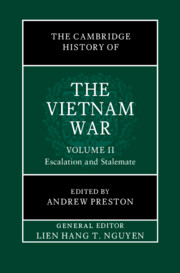Book contents
- The Cambridge History of the Vietnam War
- The Cambridge History of the Vietnam War
- The Cambridge History of the Vietnam War
- Copyright page
- Contents
- Figures
- Maps
- Tables
- Contributors to Volume II
- General Introduction
- Introduction
- Part I Battlefields
- 1 Reconsidering American Strategy in Vietnam
- 2 The Air Wars in Vietnam
- 3 US Combat Soldiers in Vietnam
- 4 American Women and the Vietnam War
- 5 The Conundrum of Pacification
- 6 The US Military Presence in South Vietnam
- 7 The ARVN Experience
- 8 The National Liberation Front
- 9 The People’s Army of Vietnam
- 10 Vietnamese Women and the War
- 11 Vietnam’s Ethnic Minorities at War
- 12 The War in Numbers
- 13 The Tet Offensive
- Part II Homefronts
- Part III Global Vietnam
- Index
12 - The War in Numbers
from Part I - Battlefields
Published online by Cambridge University Press: 02 January 2025
- The Cambridge History of the Vietnam War
- The Cambridge History of the Vietnam War
- The Cambridge History of the Vietnam War
- Copyright page
- Contents
- Figures
- Maps
- Tables
- Contributors to Volume II
- General Introduction
- Introduction
- Part I Battlefields
- 1 Reconsidering American Strategy in Vietnam
- 2 The Air Wars in Vietnam
- 3 US Combat Soldiers in Vietnam
- 4 American Women and the Vietnam War
- 5 The Conundrum of Pacification
- 6 The US Military Presence in South Vietnam
- 7 The ARVN Experience
- 8 The National Liberation Front
- 9 The People’s Army of Vietnam
- 10 Vietnamese Women and the War
- 11 Vietnam’s Ethnic Minorities at War
- 12 The War in Numbers
- 13 The Tet Offensive
- Part II Homefronts
- Part III Global Vietnam
- Index
Summary
Most of the available statistics on the Vietnam War come from the US government. Those for US military personnel strengths in Vietnam, and US casualties, are relatively accurate. Most of the rest are problematic. Republic of Vietnam Armed Forces personnel strengths were exaggerated; more men were listed on unit rosters than were actually serving. US figures for RVNAF casualties were below the actual levels in some periods. US estimates of communist personnel strength were usually well below the actual level. In US figures for communist losses, inflated “body counts” were balanced by communist personnel who died under circumstances not allowing US or RVN forces to count their bodies, so the overall totals may not have been exaggerations. The United States used air power on a huge scale. The bomb tonnage delivered on South Vietnam was the largest for any country in history, and that on Laos the second-largest. But it was indigenous forces that did most of the ground combat and therefore suffered most of the losses. The number of RVNAF personnel who died was far larger than the number of Americans. The number of communist personnel who died was larger still.
Keywords
- Type
- Chapter
- Information
- The Cambridge History of the Vietnam War , pp. 260 - 280Publisher: Cambridge University PressPrint publication year: 2024

